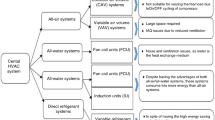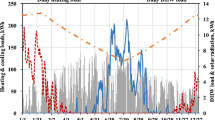Abstract
Performance of a cross flow direct evaporative cooler under different indoor and outdoor conditions was investigated by a thermodynamic model and using finite difference scheme. Unlike the previous studies, the temperature variation of water film during the evaporation process was included among the modeling, and the error of the mathematical model to estimate the effectiveness of the cooler became lower than the error reported in the literature. To achieve the comprehensive results and evaluation of the applicability of the system under real conditions, the performance of the cooler in ambient temperatures of 25, 30, 35 and 40 °C, relative humidities of 10, 30, 50 and 70% and cooling demand of 1–5 kW for a building with air changes of 5, 10 and 15 per hour was investigated. Lastly, the study on the performance of the cooler in different Iranian provincial capitals showed that for air change of 15 per hour and cooling demand of 1 kW, the system could provide thermal comfort conditions in 24 provincial centers while for air change of 5 per hour and cooling load of 5 kW, this goal cannot be achieved in any centers. Moreover, comparing the water consumption of the coolers showed that the maximum and minimum daily water consumption was for Yazd in September and for Kermanshah on July, respectively. Investigation of the coefficient of performance of the system for air changes of 10 and 15 per hour revealed that Khoramabad and Bandar Abbas had the maximum and minimum coefficients of performance, respectively.












Similar content being viewed by others
Abbreviations
- ACH:
-
Air change rate, 1/h
- COP:
-
Coefficient of performance
- A:
-
Surface area perpendicular to air flow direction, m2
- C:
-
Specific heat capacity, J/kgK
- h a :
-
Convective heat transfer coefficient, W/m2K
- h d :
-
Mass transfer coefficient, kg/m2s
- H :
-
Specific enthalpy, J/kg
- H fg :
-
Latent heat of water, J/kg
- K :
-
Thermal conductivity, W/m2K
- l e :
-
Characteristic length, m
- Lx,Ly and Lz :
-
Length of the cooler along x, y and z coordinates
- m :
-
Mass flow rate, kg/s
- p :
-
Pressure, Pa
- P :
-
Power consumption, W
- Q :
-
Heat transfer rate, W
- T :
-
Temperature, °C
- u :
-
Air velocity into the cooler, m/s
- V :
-
Building volume, m3
- β :
-
Pad heat transfer area to volume, 1/m
- η :
-
Efficiency
- υ :
-
Kinematic viscosity, kg/m.s
- ρ :
-
Density; kg/m3
- ω :
-
Humidity ratio, (kgwater/kgair
- Nu:
-
Nusslet number (\(\mathrm{Nu}=0.1{(\frac{{l}_{e}}{l})}^{0.12}{\mathrm{Re}}^{0.8}{\mathrm{Pr}}^\frac{1}{3}\))
- Re:
-
Reynolds number (\(\mathrm{Re}=\frac{{u}_{a}.{l}_{e}}{\nu }\))
- Le:
-
Lewis number (\(\mathrm{Le}=\frac{{h}_{a}}{{C}_{p}{h}_{d}}\)
- i :
-
Inlet
- l :
-
Latent
- o :
-
Outlet
- s :
-
Sensible
- v :
-
Vapor
- w :
-
Water
- n :
-
Number of iterations
References
Al-Badri, A. R., & Al-Waaly, A. A. (2017). The influence of chilled water on the performance of direct evaporative cooling. Energy and Buildings, 155, 143–150.
BIS, B.o.I.S. (1997). Handbook of functional requirements of buildings, Bureau of Indian Standards, New Delhi, India.
Bishoyi, D., & Sudhakar, K. (2017). Experimental performance of a direct evaporative cooler in composite climate of India. Energy and Buildings, 153, 190–200.
Camargo, J. R., Ebinuma, C. D., & Silveira, J. L. (2005). Experimental performance of a direct evaporative cooler operating during summer in a Brazilian city. International Journal of Refrigeration, 28(7), 1124–1132.
Dai, Y. J., & Sumathy, K. (2002). Theoretical study on a cross-flow direct evaporative cooler using honeycomb paper as packing material. Applied Thermal Engineering, 22(13), 1417–1430.
Dowdy, J. A., & Karabash, N. S. (1987). Experimental determination of heat and mass transfer coefficients in rigid impregnated cellulose evaporative media. ASHRAE Transactions, 93(2), 382–395.
EESTI-Standardikeskus. (2006). EVS-ISO 7730, ergonomics of the thermal environment-Analytical determination and interpretation of the thermal comfort using calculation of the PMV and PPD indices and local thermal comfort criteria. Geneva, Switzerland.
Fiorentino, M., & Starace, G. (2016). Numerical investigations on two-phase flow modes in evaporative condensers. Applied Thermal Engineering, 94, 777–785.
Fiorentino, M., & Starace, G. (2018). The design of countercurrent evaporative condensers with the hybrid method. Applied Thermal Engineering, 130, 889–898.
Fouda, A., & Melikyan, Z. (2011). A simplified model for analysis of heat and mass transfer in a direct evaporative cooler. Applied Thermal Engineering, 31(5), 932–936.
Gilani, N., & Poshtiri, A. H. (2014). Heat exchanger design of direct evaporative cooler based on outdoor and indoor environmental conditions. Journal of Thermal Science and Engineering Applications, 6(4), 1–9.
Gilani, N., & Poshtiri, A. H. (2017). Thermal design of two-stage evaporative cooler based on thermal comfort criterion. Heat and Mass Transfer, 53(4), 1355–1374.
Heidarinejad, G., Khalajzadeh, V., & Delfani, S. (2010). Performance analysis of a ground-assisted direct evaporative cooling air conditioner. Building and Environment, 45(11), 2421–2429.
International Standardization Organization. (1993). ISO7730, moderate thermal environments determination of the PMV and PPD indices and specification of the conditions for thermal comfort: ISO, Geneva, Switzerland.
Kabeel, A. E., & Bassuoni, M. M. (2017). A simplified experimentally tested theoretical model to reduce water consumption of a direct evaporative cooler for dry climates. International Journal of Refrigeration, 87, 487–494.
Kim, M. H., Kim, J. H., Kwon, O. H., Choi, A. S., & Jeong, J. W. (2011). Energy conservation potential of an indirect and direct evaporative cooling assisted 100% outdoor air system. Building Services Engineering Research and Technology, 32(4), 345–360.
Kovačević, I., & Sourbron, M. (2017). The numerical model for direct evaporative cooler. Applied Thermal Engineering, 113, 8–19.
Laknizi, A., Mahdaoui, M., Ben Abdellah, A., Anoune, K., Bakhouya, M., & Ezbakhe, H. (2018). Performance analysis and optimal parameters of a direct evaporative pad cooling system under the climate conditions of Morocco. Case Studies in Thermal Engineering, 13, 1–11.
Navon, R., & Arkin, H. (1994). Feasibility of direct-indirect evaporative cooling for residences, based on studies with a desert cooler. Building and Environment, 29(3), 393–399.
Sheng, C., & Nnanna, A. A. (2012). Empirical correlation of cooling efficiency and transport phenomena of direct evaporative cooler. Applied Thermal Engineering, 40, 48–55.
Silva, A., Neto, J. C., & Lamberts, R. (2004). Modeling spray vaporization for evaporative cooling of buildings. Building Services Engineering Research and Technology, 25(4), 351–361.
Wang, S.K. Handbook of air conditioning and refrigeration. McGraw-Hill Education; 2 edition (November 7, 2000).
Wu, J. M., Huang, X., & Zhang, H. (2009). Theoretical analysis on heat and mass transfer in a direct evaporative cooler. Applied Thermal Engineering, 29(5), 980–984.
Acknowledgements
The authors would like to acknowledge Faculty of Mechanical Engineering, University of Guilan for the virtual support.
Author information
Authors and Affiliations
Corresponding author
Rights and permissions
About this article
Cite this article
Mahmoudi, H.B., Poshtiri, A.H. & Poorkashani, P. Mathematical modeling and study on the application of cross flow direct evaporative cooler under different indoor and outdoor environmental conditions. Int J Energ Water Res 4, 465–483 (2020). https://doi.org/10.1007/s42108-020-00088-z
Received:
Accepted:
Published:
Issue Date:
DOI: https://doi.org/10.1007/s42108-020-00088-z




